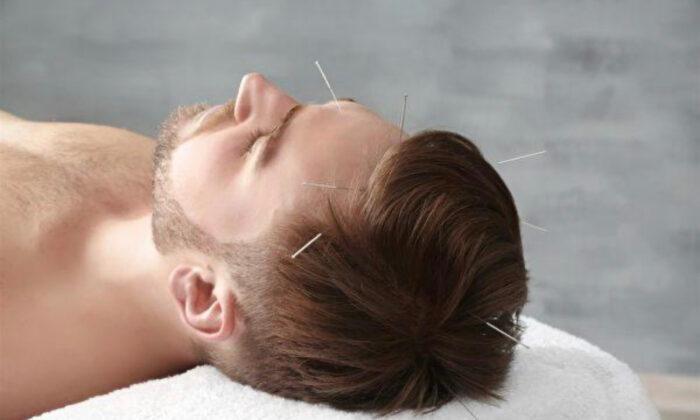Thrombosis, or blood clots that block veins or arteries, is one of the complications of COVID-19. Research has found that the incidence of arterial and venous thrombosis increases significantly in COVID-19 patients.
In addition, some people have rare side effects such as thrombosis with thrombocytopenia syndrome after they get vaccinated; antibodies produced by the vaccine activate platelets, resulting in low platelet count and blood clots.
Western medicine usually prescribes anticoagulant (blood thinning) and thrombolytic (blood clot-disrupting) therapy to treat thrombosis. However, this also carries the risk of side effects such as bleeding and allergies.
Traditional Chinese medicine (TCM) has a long history of curing thrombosis, even in cases that anticoagulants fail to treat.
Incidence Rate of Thrombosis Increased Significantly
According to a research report released on the website of the American Heart Association, COVID-19 increases risk of thrombosis.The health records of 48 million adults in England and Wales were investigated by medical experts. They found that among nearly 1.44 million infected patients, the incidence rates of fatal arterial thrombosis and fatal venous thrombosis were 5.3 percent and 4.7 percent, respectively, and the non-fatal incidence rates of the conditions were 2.5 percent and 4.4 percent, respectively.
During the entire course of infection, the incidence rate of the formation of arterial thrombosis was significantly higher in the first few weeks of the diagnosis of COVID-19 and decreased rapidly over time, while the incidence rate of venous thrombosis decreased more slowly.
Venous thrombosis is a significant complication in long COVID-19 patients.
Causes of Formation of Thrombosis
Vascular thrombosis is common, and the incidence rate is higher in men than in women.In modern Western medicine, thrombosis is believed to be an unstructured mass formed by insoluble fibrin, deposited platelets, accumulated white blood cells, and trapped red blood cells. The main conditions that contribute to the formation of thrombosis are damage to cardiovascular endothelium (the layer of cells that line the interior of blood vessels), changes in blood flow velocity and direction, and an increase in blood coagulation. Among them, damage to the endothelium and increased blood coagulation are critical factors.
The mechanisms of the formation of arterial thrombosis and venous thrombosis are different because the physiological environments of arteries and veins are different. Arteries carry oxygenated blood away from the heart with the heartbeat. Veins carry deoxygenated blood back to the heart.
Arterial thrombosis is usually formed after atherosclerotic plaque rupture. After these plaques on the artery walls rupture, their lipid-rich core and collagen are exposed, and platelets in the blood flowing past start to adhere, activate, and aggregate, forming white thrombosis, which is rich in platelets.
COVID and Vaccine Induces Thrombosis, Thrombocytopenia Syndrome
After severe pneumonia induced by COVID-19, arterial thrombosis risk is elevated because the acute inflammatory response caused by severe infection or sepsis can affect the coagulation and fibrinolytic system that forms and prevents blood clots.This happens through various channels, such as a decrease of circulating C-reactive protein and antithrombin-Ⅲ levels or the increase of plasminogen activator inhibitor-1 levels, which eventually leads to the activation of the coagulation cascade mechanism and the inhibition of the fibrinolytic process (which breaks down and prevents clots).
An investigation of large-scale surveys in England and Ireland found that many patients developed venous thrombosis not during the acute infection, but during long COVID-19.
There were also cases of rare side effects of thrombosis with thrombocytopenia syndrome after being vaccinated with AstraZeneca Vaxzevria vaccines and Johnson & Johnson vaccines in Europe and the United States.
Modern Antithrombotic Therapy Is Limited
Treatments available include anticoagulant therapy, antiplatelet therapy, thrombolytic therapy, and fibrinogen-lowering therapy. However, these therapies have side effects such as bleeding and allergies, and some cases have contraindications. For some complex cases, modern medical therapy isn’t ideal.For example, powerful anticoagulants carry risks of bleeding. To prevent this, patients usually undergo regular blood tests. And if one has local skin ulcers, the drug may not have an effect.
8-Month Vein Thrombosis Case Treated in 20 Days
I treated a “typical” case of deep vein thrombosis in a patient’s lower left extremity. The 26-year-old said this area had been swollen and in pain for eight months; his skin was covered in purplish-black ulcers.He had been diagnosed by his family doctor eight months prior and was prescribed medication, which he took for six months without effect. Over that period of time, the ulcers—a sign of aggravated ischemia (restricted blood flow)—appeared.
This was an active young man who loved playing basketball, and he hadn’t been able to play for more than a year because of his illness. At the prompting of others, he came to consult me.
I asked about his diet, quality of sleep, urine, and stool, and all were basically normal. Therefore, according to TCM theory, this was a typical case of qi deficiency and blood stasis.
The concept of “qi” in TCM can be understood as the “energy” or “vitality” that constitutes life in the body. This energy flows throughout the body to maintain life activities. TCM theory holds that qi is the most basic and important substance that constitutes the human body and life activities.
Various phenomena in the human body are representations of energy, such as the heartbeat, lungs assisting breathing, muscle contraction, blood circulation, the conduction of nerve signals, and so on. The different forms of energy are summarized in TCM as qi. The general operation of every organ, such as the heart, liver, spleen, lung, and kidney, is driven by energy. Without energy, the organs fail.
You can think of qi as the substance that fills the total energy requirement of the body. It comes mainly from the air we breathe and the food we eat.
Qi involves blood circulation, heart function, and the balance of the coagulation and anti-coagulation mechanisms.
The expression of qi deficiency and blood stasis is that blood flows slowly and it easily coagulates and forms thrombosis. Western medicine has similar findings.
However, in TCM, this condition can be detected before thrombosis symptoms actually occur. One can experience stagnated qi and blood stasis for quite some time before thrombosis forms and causes symptoms and complications, and the TCM system recognizes many signs of the underlying stagnated qi and blood stasis problem, meaning it can be treated early.
I adopt the treatment of invigorating qi and activating blood with TCM prescriptions that can supplement the energy constituting life, improving blood circulation and other functions.
For instance, the treatment of rejuvenation soup from Dr. Men Chunde, a famous TCM practitioner from Hebei Province, China, is very effective in curing this disease.
This prescription includes Astragalus, a genus of herb used in Chinese medicine to invigorate qi, Angelica, Caulis spatholobus, and Salvia siltiorrhiza, and insect medicines such as earthworm, ground beetle, leech herbs, and so on, which are effective in promoting blood circulation and expanding vessels. These should be prescribed by an experienced and trusted TCM doctor.
I prescribed medicine for the young man who came to see me, and he took 20 doses in 20 days. By the end of it, all the symptoms disappeared, the skin ulcers on his lower limbs healed, his skin color returned to normal, and he could run on the basketball court again.
“When the meridians are open, the blood and qi can flow,” reads the Yellow Emperor’s Inner Canon, a seminal TCM classic written 2,500 years ago. It means that blood circulation will be normal when the blood vessels are healthy.
4 Habits for Preventing Thrombosis
There are best practices that we can incorporate into our daily life to prevent thrombosis, and many of them are not so difficult.An important strategy to prevent thrombosis is to adopt a less sedentary lifestyle. Many jobs require long hours of sitting, but you can implement small fixes. After using the computer for an hour, stand up, stretch your arms and legs, and take a quick walk down the hall if you can. If you can’t leave your desk, move your ankle joints, turning your toes inward and then outward. Stretch your calf muscles and hold for a few seconds.
Just by doing this, you promote blood circulation effectively and reduce the chance of blood coagulation and blockage formation.
People who are bedridden for a long time are at high risk of lower extremity venous thrombosis. Bedridden patients should be encouraged to move their lower extremities.
Patients who need long-term intravenous infusion should avoid repeated punctures at the same place. Once the venous endothelium is damaged, thrombosis will easily form.
Try to arrange your meals such that they are balanced and well-timed. Some foods that prevent thrombosis are sardines, onions, garlic, celery, and black fungus. These foods do not increase blood viscosity, and they prevent blood clotting.
Many patients with thromboangiitis are longtime smokers. Smoking damages blood vessels, and quitting is an important way to prevent thrombotic diseases.
Drink plenty of water. The average person should drink 50 to 70 ounces of water per day, while the elderly need to drink more water because the blood of the elderly is relatively thick and coagulated.
Drinking more water can help dilute the blood. Drinking water when you get up and before going to bed can reduce blood viscosity and the formation of thrombosis.
Danshen Tea Can Reduce the Risk of Thrombosis
Modern pharmacology has discovered that many TCM blood-activating and stasis-removing herbal drugs have antithrombotic functions, but this effect is different from that in chemical drugs.This medicine works not by targeting a certain session where blood agglutinates, but through anti-inflammation and expanding blood vessels, reducing blood pressure, reducing blood viscosity and blood lipids, inhibiting platelet aggregation, and improving blood microcirculation and other microscopic functions.
The preferred TCM treatment for promoting blood circulation and removing blood stasis is danshen, also known as Salvia miltiorrhiza, or red sage. It can sometimes be obtained in health food stores. Better yet, get it from a trusted TCM practitioner.
People with high risk factors for thrombosis can brew tea from 10 grams of danshen every day to prevent thrombosis.
Just as important as these treatments is to quit bad habits and maintain a healthy life because ultimately, our health depends on us.




